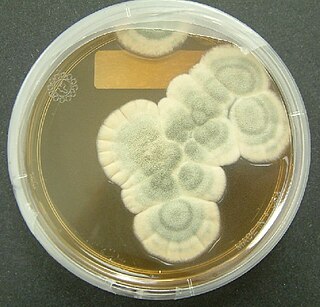Penicillin
group of antibiotics derived from Penicillium fungi From Wikipedia, the free encyclopedia
Remove ads
Penicillin is a group of common antibiotics, made to treat bacterial infections. It was one of the first antibiotics to be discovered, and worked well against staphylococci and streptococci. Many strains of bacteria are now resistant. Chemists and many businesses keep changing part of its structure in the effort to keep it working against the bacteria. Penicillin is sometimes made to treat syphilis, tonsillitis, meningitis, and pneumonia as well as other diseases.


Remove ads
Mechanism
Penicillin can be used to enter and kill two types of bacteria, Gram-positive and Gram-negative bacteria. It does this by lysis of the cell membrane[verification needed]. Gram-positive bacteria have no outer cell membrane (protective layer around the bacteria cell) and have large pores (holes) which allows penicillin to enter easily and kill the cell from the inside.[1] Gram-negative bacteria are harder for penicillin to enter as they have smaller pores and an outer cell membrane so penicillin has to enter through smaller aqueous pores (holes in the membrane where water enters and leaves the cell). This means that killing Gram-negative bacteria takes a longer amount of time and some penicillin drugs may not work against them.[2]
Once the Penicillin is inside the bacteria, it destroys the cell wall by stopping new chains in the outer membrane from forming and so the structure of the membrane collapses. This means that there is no longer a structure to support the cell and control how much of substances can enter and leave so a large amount of water from the surroundings enters the cell until it can no longer function and so the cell dies.[3]
Remove ads
History
Penicillin was discovered by Scottish scientist Sir Alexander Fleming in 1928, but it was not mass-produced until 1940[4] when it was first used widely during World War II.
Penicillin was discovered when Fleming noticed a mold that was stopping bacteria from growing in a petri dish. Australian scientist Howard Walter Florey made the penicillin mold into a medicine. Together with another scientist Ernst Boris Chain, Fleming and Florey were given the Nobel Prize for Medicine in 1945. The first time penicillin was used in medicine to treat a bacterial infection was in 1930.
Remove ads
Modern day use
The antibiotic penicillin is naturally produced by fungi of the genus Penicillium.[5] There is now a whole group of antibiotics derived from Penicillium including penicillin G, procaine penicillin, benzathine penicillin, and penicillin V which are effective against different bacterial diseases.
Some people are allergic to penicillin. Side effects of taking antibiotics may include nausea, diarrhea, or a rash. Rarely, patients who are allergic to penicillin get a fever, vomit, or have serious skin irritation. Because it is such a popular antibiotic, penicillin is the most common cause of serious allergic reactions to a drug. The amount of penicillin allergies out there is said to be overstated (they think there are more than there are).
They are now used regularly in hospitals but because its use is so common in modern medicine, strains of bacteria have developed resistance against the antibiotic. This means the antibiotic can no longer kill those bacteria.
Total synthesis
Chemist John C. Sheehan at the Massachusetts Institute of Technology (MIT) did the first chemical synthesis of penicillin in 1957.[6][7][8]
References
Wikiwand - on
Seamless Wikipedia browsing. On steroids.
Remove ads
